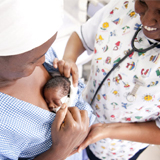
Community Kangaroo Mother Care: A training module was developed to guide the training of community health care workers in Kangaroo Mother Care. As the implementation of Community Kangaroo Mother Care (CKMC) will vary, users are encouraged to adapt the content as needed or appropriate. Potential uses for the manual might be:
- As a module to integrate into existing training programs for community providers;
- As a technical resource for CKMC; and/or
- As a separate in-service training for practicing community providers
Each topic has objectives, a session plan, trainer’s notes and learning activities.
In the appendix, there is a section to help and guide trainers who wish to integrate the module into existing programs. Other tools for trainers include a pre/post course questionnaire to use as appropriate, trainers’ checklists and a list of technical resources. For learners who are semi or non-literate, an example of verbal skills and knowledge tests is included.
At a minimum, CKMC trainers should have a background in community-based health care and be experienced in maternal-newborn care service delivery, including care of low birth-weight newborns. At least some prior experience in KMC practice is desirable. Training expertise is required with skills in the competency-based approach for both facility and community-based providers.
It is assumed that learners will also have some training or experience in health care provision, specifically maternal-newborn care. This is not designed to be a course in essential newborn care. There are many excellent resources for that purpose, some of which are listed in the appendix. Rather, it is designed to help train health workers in implementing CKMC.
Essential to any successful program is an enabling environment. Community KMC will only work when community members, health providers, referral facilities and the health care system all support the household to hospital continuum of health care. In general, the following must be in place before CKMC training is planned:
- Training and orientation of staff in referral facilities at all levels
- Ideally, a KMC unit at the nearest facility
- Training of supervisors for community health workers
- Sensitization and education of communities involved
- Persons responsible for community mobilization must be oriented to KMC in order to appropriately sensitize community leaders and members
- Training and orientation of birth attendants in KMC since it must be started immediately after birth; this includes training of antenatal providers
- KMC education for all pregnant and postpartum mothers and their families
- A functioning referral system
- Community health workers trained in basic maternal-newborn health services
A final assumption is related to the application of KMC in the community context: KMC is practiced for all babies and not just those who are low birth weight. With universal CKMC, the benefit to small babies is ensured. This is especially the case in settings where the rate of small or low birth weight babies is high. Since availability of weighing scales is not universal, however, the assessment of “small” in many CKMC programs will be based on the mother’s (and/or birth attendant’s) perception of the baby’s size (weight). At least one study has demonstrated that the mother’s perception of size was a good proxy for birth weight .
Though Kangaroo Mother Care has been around for many years, documented experience in the community setting is limited. Where feasible, the information and skills provided in the pages that follow are based on evidence and the most current KMC literature available.
Note: throughout this manual, the word “small” is used to refer to both low-birth weight and pre-term infants.
Please download the resource to view the full guide.